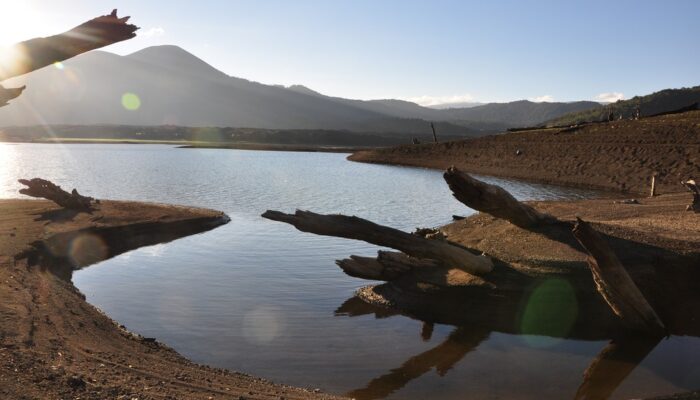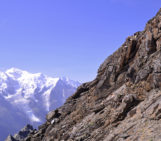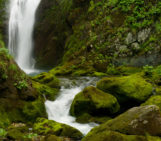
As Earth’s environment changes, it leaves behind clues used by scientists to paint portraits of the past: scorched timber, water-weathered shores, hardened lava flows. Chile’s Conguillío National Park is teeming with these kind of geologic artifacts; some are only a few years old while others have existed for more than 30 million years. The photographer Anita Di Chiara, a researcher at Lancaster University in the UK, describes how she analyses ancient magnetic field records to learn about Earth’s changing crust.
Llaima Volcano, within the Conguillío National Park in Chile, is in the background of this image with its typical double-hump shape. The lake is called Lago Verde and the trunks sticking out are likely remnants from one of the many seasonal fires that have left their mark on this area (the last one was in 2015).
The lake sits on pyroclastic deposits that erupted from the Llaima Volcano. On these deposits, on the side of the lake, you can even track the geologic record of seasonal lake level changes, as the layers shown here mark the old (higher) level of the lake during heavy winter rains.
The lake also overlaps the Liquiñe-Ofqui Fault, which runs about 1000 kilometers along the North Patagonian Andes. The fault has been responsible for both volcanic and seismic activity in the region since the Oligocene (around 30 million years ago).
I was there as field assistant for Catalina Hernandez Moreno, a geoscientist at Italy’s National Institute of Geophysics and Volcanology, studying ancient magnetic field records imprinted on rocks. We examined the rocks’ magnetised minerals (aligned like a compass needle to the north pole) as a way to measure how fragmented blocks of the Earth’s crust have rotated over time along the fault.
From this fieldwork we were able to examine palaeomagnetic rotation patterns from 98 Oligocene-Pleistocene volcanic sites. Even more, we concluded that the lava flows from the Llaima Volcano’s 1958 eruption would be a suitable site for studying the evolution of the South Atlantic Anomaly, an area within the South Atlantic Ocean where the Earth’s magnetic field is mysteriously weaker than expected.
By Anita Di Chiara, a research technician at the Lancaster Environment Centre in the UK
References
Hernandez-Moreno, C., Speranza, F., & Di Chiara, A.: Understanding kinematics of intra-arc transcurrent deformation: Paleomagnetic evidence from the Liquiñe-Ofqui fault zone (Chile, 38-41°S), Tectonics, https://doi.org/10.1002/2014TC003622, 2014.
Hernandez-Moreno, C., Speranza, F., & Di Chiara, A.: Paleomagnetic rotation pattern of the southern Chile fore-arc sliver (38°S-42°S): A new tool to evaluate plate locking along subduction zones. Journal of Geophysical Research: Solid Earth, 121(2), https://doi.org/10.1002/2015JB012382, 2016.
Di Chiara, A., Moncinhatto, T., Hernandez Moreno, C., Pavón-Carrasco, F. J., & Trindade, R. I. F.: Paleomagnetic study of an historical lava flow from the Llaima volcano, Chile. Journal of South American Earth Sciences, 77, https://doi.org/10.1016/j.jsames.2017.04.014, 2017.
Imaggeo is the EGU’s online open access geosciences image repository. All geoscientists (and others) can submittheir photographs and videos to this repository and, since it is open access, these images can be used for free by scientists for their presentations or publications, by educators and the general public, and some images can even be used freely for commercial purposes. Photographers also retain full rights of use, as Imaggeo images are licensed and distributed by the EGU under a Creative Commons licence. Submit your photos at http://imaggeo.egu.eu/upload/.


